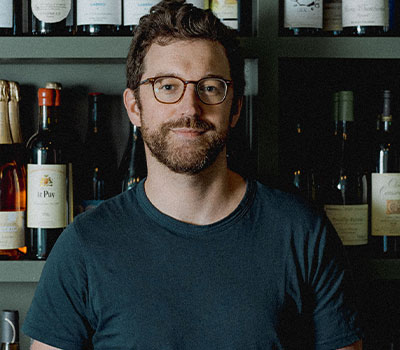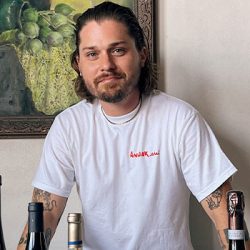Richard Hargreave and Claudia Lee own Underdog, a wine bar with a Korean menu that would put many restaurants to shame. Hargreave is British, but worked with David Chang for many years, as part of a kind of advance team opening restaurants for him in New York, Las Vegas, Sydney, and Los Angeles. Along the way he’s had stints in Bali and Singapore. With that direct experience in Asian cuisines, he comes to each menu brimming with interesting pairing ideas to work with Korean dishes, a cuisine devoted to charcoal-grilled meats, pickled vegetables and plenty of heat. —Patrick J. Comiskey


How did you end up at in Austin?
When I finished up working with Momofuku at the end of 2019, I took a job as the global F&B Director for a really interesting Hospitality Group called Potato Head, a resort company based in Bali, Indonesia, with outposts in Singapore. I moved to Bali in January 2020, came back in March 2020. That was when COVID really started to pop in the United States. I spoke to my boss and he told me to stay here. It’s much safer in the United States than in Bali. I ended up never going back.
By May 2020, Claudia [Lee, business and life-partner] and I were, just like everyone else, sitting at home, and we started wondering, what do we do? Do we go back to working for someone else? Or do we use this time to build a business plan and come up with a concept. The business plan evolved from us sitting at home, drinking lots of wine, eating lots of Korean food, and just realizing how good they are together. We decided to open a wine bar and restaurant serving food and wine that we love.
We wanted to open somewhere we knew wouldn’t be shut down for months on end. And, at the time, Texas was a more favorable state for small businesses. Claudia had never lived anywhere outside of Los Angeles, outside of her years at college in Arizona, and she had a bunch of friends that lived in Austin. They’re always telling her how great it was. I’m used to being nomadic; I’ve bopped around cities all over the place.
So Claudia’s Korean. Is she back-of-the-house or does she oversee things?
Her mother, Christina, comes by and helps a lot with the classical techniques that some of the young cooks don’t know. But we have a Korean head chef, Nathan Gil, who did an externship with Corey Lee at Benu, as well as other places.
How did you find him?
He found us. He was working on the coast—he’s from Orange County, but was visiting his brothers here, basically to see what it would be like to live here. And he was literally at the airport, and read about us and reached out to us directly— “I’m looking to move here, your concept seems perfect for who I am and what I am about.” And the rest is history.
It sounds as though it’s quite a bit more than a wine bar, then, if you’ve got a chef who’s got experience at a place like Benu.
It’s definitely evolving into more of a restaurant than just a wine bar, that’s for sure. I think the term wine bar means something different now than what it meant ten or fifteen years ago. It’s a lot looser and broader. I was very much going for the sorts of places like Septime or Clamato in Paris, or Four Horsemen in New York, with big robust food menus, where the food offering is almost better than at a restaurant. We call ourselves a wine bar predominantly because we want the focus to be on wine.
What was your first job in the wine business?
It was at a store in England, Oddbins. I had just turned eighteen.
My mother had a café restaurant in a small town in England. I would run over to Oddbins—underage mind you—and buy some wine from them for the for the restaurant. And I was drawn to, not so much the wine, it was a person, this passionate young manager who I looked forward to seeing when I went in there because he would always get so excited about stuff, and he got me excited, and I wasn’t even a huge wine drinker at the time. Oftentimes, it’s not just the wine, it’s whoever is doing the explaining, helping you to explore wine and selling that dream to you, as well.
Once I turned eighteen, this guy said, ‘Do you want to come and work here?’ And I was like, ‘Hell yeah, I do.’ I worked under him for six months. And then he left. They didn’t replace him; they just made me the manager. So by eighteen-and-a-half, I was running the place. For the restaurant wine side, I moved to Sydney, Australia, when I was 21 to study and stayed.
Where did you work in Sydney?
I got my first official sommelier job at Quay, which is still going strong to this day. The GM was interviewing me and said, ‘Would you be interested in a sommelier position?’ It was something I’d never even thought of before. I still had a bit of impostor syndrome but I was like, ‘Sure.’ And I just faked it till I made it, basically, and just kept learning and learning. Eventually I opened Momofuku in Sydney, and helped Dave [Chang] open a number of his restaurants, in New York, Las Vegas, and eventually Majordomo in Los Angeles.
Which regions of wine interest you the most?
Right now I am really into Southwest France. Two of the most memorable wines I had last year were both from Jurançon, both still whites. One was a current vintage gros manseng and one was a gros manseng that was seven or eight years under the veil [of yeast], both were spectacular, really eye opening for me, and made me want to explore that region more. And I’m loving what I’m trying—the grenaches and cinsaults from the Southwest [of France] have been really exciting. And almost more so the whites, especially from these younger winemakers who’ve got that balance between freshness and power and texture, but without too much alcohol, maintaining that saline character. I would say that Roussillon would be my number one place, especially for whites, which I never thought I’d say.
But there are some classic whites from that region that are certainly world class. One producer that got me excited is Domaine Danjou Banessy, in Cotes Catalanes: their Supernova, a skin contact wine, and another one called La Truffière. It drinks like a young Roulot—there’s a gentle reduction in it—but it has very powerful acidity and minerality for the money.
I can imagine that these wines do exceptionally well with Korean food…
Absolutely. Yeah, that’s one of the main things that we’ve realized. I mean, Korean and Chinese [Momofuku etc.] are completely different cuisines, but Chinese food and Korean food are made for bottles of wine like these, wines that have some body but are mineral, edgy, with a focused salinity and the suppleness to manage a little heat.
Are there any categories or regions that have taken off at Underdog?
This might be a Texan thing, but sangiovese does tremendously well—particularly Chianti and Chianti Classico; I just don’t really know what the reason is; I think sangiovese is exotic enough to people to satisfy some curiosity, but also familiar enough to know that the risk isn’t high. It’s familiar, but not. People really seem to be drawn to it. They know what they’re getting, but they’re also feeling like they’re pushing the boat out away from shore. It happens to go really well with the food here: Right now, it’s the best pairing we have for the grilled kalbi—short ribs over the charcoal. So, you get some smoke and you get some fat and you get that Texas flavor. Texas beef is not like any other beef I’ve ever had. It’s really beefy, with an intense meatiness to it and we love it. We’ve literally changed the whole menu to build around Texas beef. It pairs really well with a good bottle of Chianti Classico from a good producer, even a good Brunello. The best pairing I’ve had, since we’ve been open has been the Stella di Campalto Rosso di Montalcino. That wine, with the kalbi, was spectacular.
Are there categories or regions driving interest that came out of nowhere for you this year?
I will say having worked on the East and West coasts and not knowing exactly what the market was like in Texas, it’s all been a little unexpected. But I was shocked at how many people were asking me for orange wine—from day one. And it’s not just the wine people; it’s everyone, all demographics. It’s been our biggest seller, even in the summer. The two big things that we get asked for more than anything now are orange wines and chilled reds. In the spring and summer, that’s all we sold.
There are enough people now talking about it, and representing it, that they’ve almost become mainstream. That was my big takeaway from this year: It’s not as though orange wine or chilled reds need as much literature or promotion. Orange wine is established. It’s here now. People are coming in and saying, can you show me your orange wines? And I’m like, ‘Okay’… because we don’t list it; we don’t have an orange wine section.
For chilled reds, we’ve had a lot of success with a wine that’s actually, technically, not a red. It’s a cerasuolo d’Abruzzo, so it’s more like a deeper rosé, essentially. We work with a producer called Agricola Caprera, from a young winemaker named Luca Paolo, who used to be a somm, and jumped over into the winemaking world. His cerasuolo is fantastic. It’s also a fantastic food-pairing wine. It’s lighter tannins really go well with gigae, a kimchi soup, which is one of the harder Korean dishes to pair with.
Orange wine is a lot harder to find. There’s so much demand for it now, especially in by-the-glass price points, that anything $25 wholesale just get snapped up. But we’ve had a few really good values on that we’ve had a lot of success with. Like Chateau Maris. It’s a light skin contact. It’s very inexpensive. More fruit forward than some but still with some structure. So, something like this is a great way to get people into it, before we start talking about Gravner and things like that. Dip our toe in the water and do a low maceration wine.
By the bottle we’ve done very well with the Comando G Camino del Pilar, a white wine that goes under flor and is salty and complex. I love how it is constantly evolving throughout the meal, and the underlying salinity and funk is a perfect foil for so much of our food. Pork and shrimp mandu with truffle soy, scallion & shiitake pancake, or roasted pork collar with pickled shallot, all of these benefit from the way the wine weaves around them.
Patrick J. Comiskey covers US wines for Wine & Spirits magazine, focusing on the Pacific Northwest, California’s Central Coast and New York’s Finger Lakes.
This is a W&S web exclusive. Get access to all of our feature stories by signing up today.



















